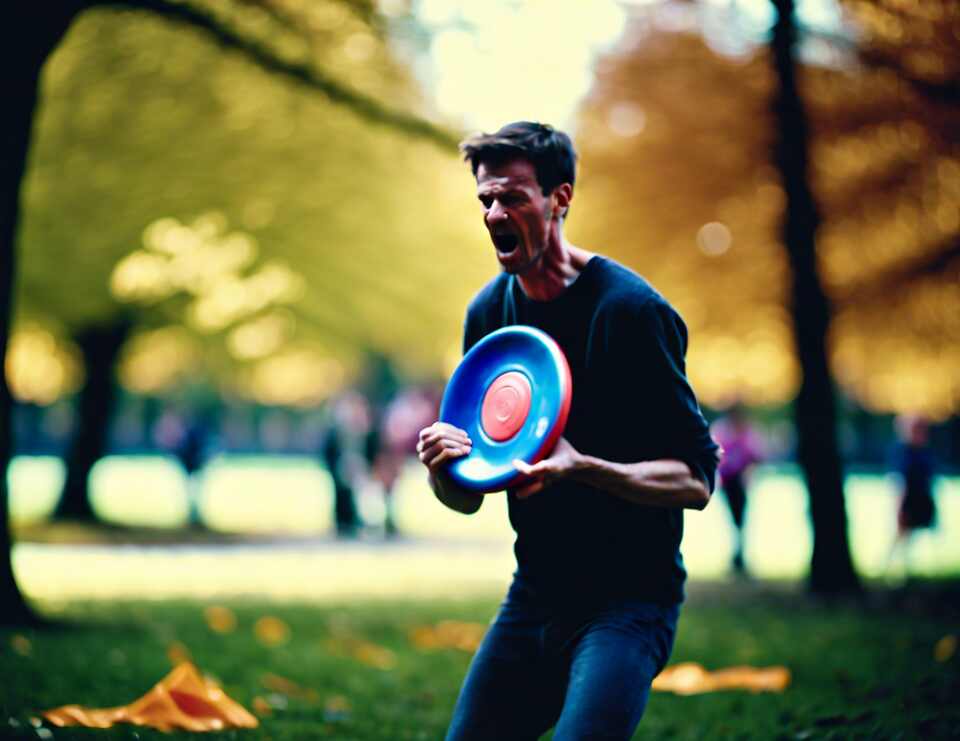Wondering if your love for disc golf might be taking a toll on your back? Join us as we look into the potential effects of this beloved sport on your spinal health. From proper form to injury prevention, let’s explore how to enjoy disc golf while safeguarding your well-being.

The Impact of Disc Golf on Your Back Health
Playing disc golf can have both positive and negative impacts on your back health. While disc golf is a fun and engaging outdoor activity that provides various health benefits, it can also pose risks to your back if not approached with caution. It is essential to understand how disc golf can affect your back to ensure that you can continue enjoying this sport safely.
Disc golf involves repetitive motions such as twisting, bending, and reaching during the throwing and retrieving of discs. These movements can put strain on your back muscles and joints, especially if proper form and technique are not maintained. Over time, this strain can lead to injuries such as muscle strains, sprains, and even disc herniation, causing back pain and discomfort.
One of the primary reasons disc golf can be bad for your back is incorrect form. Improper throwing techniques, like using excessive force or twisting your body unnaturally, can increase the risk of back injuries. Additionally, carrying a heavy bag of discs or repeatedly bending over to pick up discs can also contribute to back strain.
While disc golf is a fantastic way to stay active and enjoy the outdoors, it is essential to be mindful of how it can impact your back health. By practicing proper techniques, maintaining good posture, and taking preventive measures, you can minimize the risk of back injuries and continue to play disc golf safely for years to come.
Proper Techniques to Prevent Back Injuries in Disc Golf
Disc golf is a fun and engaging sport that can provide excellent physical exercise, but it’s essential to practice proper techniques to avoid back injuries. Here are some useful tips to help you prevent strains and injuries while enjoying your game:
1. Warm-Up and Stretch:
Before you start playing disc golf, it’s crucial to warm up your muscles and stretch properly. Focus on stretching your back, shoulders, and hamstrings to increase flexibility and reduce the risk of injury.
2. Use the Right Form:
Proper form is key to preventing back injuries in disc golf. Focus on maintaining a straight back, bending your knees, and engaging your core muscles when throwing the disc. Avoid twisting your torso excessively, as this can strain your back.
3. Choose the Correct Disc:
Using the right disc for your skill level and throwing technique can significantly reduce the strain on your back. Beginners should opt for lightweight discs that are easier to control, while more experienced players can experiment with different disc types to find the best fit for their throwing style.
4. Practice Good Posture:
Maintaining good posture throughout your game is essential for back health. Stand with your feet shoulder-width apart, distribute your weight evenly, and avoid slouching or hunching over when preparing to throw.
5. Take Breaks and Stay Hydrated:
Listen to your body and take breaks when needed to rest and rehydrate. Disc golf can be physically demanding, so it’s vital to give your back and muscles time to recover during long rounds.
6. Strengthen Your Core:
A strong core can provide crucial support for your back during disc golf. Incorporate core-strengthening exercises into your fitness routine to help improve stability and reduce the risk of back injuries.
By following these proper techniques and tips, you can enjoy playing disc golf while minimizing the risk of back injuries and maintaining good back health for years to come. Remember to listen to your body, invest time in proper warm-ups, and practice safe throwing techniques to make the most of your disc golf experience.
Common Back Injuries Caused by Playing Disc Golf
Common Back Injuries Caused by Playing Disc Golf
Disc golf is a popular recreational sport that offers a fun way to stay active and enjoy the outdoors. However, like any physical activity, disc golf can pose risks to your back health if proper precautions are not taken. Understanding the common back injuries associated with playing disc golf is essential for preventing potential long-term issues.
1. Muscle Strains: One of the most common back injuries in disc golf is muscle strains. The repetitive motion of throwing discs and navigating challenging courses can put strain on the muscles in your back, leading to discomfort and potential injury if not addressed properly.
2. Herniated Discs: The forceful twisting and turning motions involved in disc golf can increase the risk of herniated discs. When the soft cushioning discs between the vertebrae rupture or bulge, it can put pressure on the surrounding nerves, causing pain, numbness, and weakness in the back and legs.
3. Sciatica: Sciatica can also be a result of playing disc golf, especially if proper form is not maintained during throws. The sciatic nerve runs from the lower back down the legs, and irritation or compression of this nerve can lead to sharp pain, tingling, and numbness along its pathway.
4. Spondylolisthesis: This condition occurs when a vertebra slips out of place and onto the vertebra beneath it. The repetitive impact and strain on the spine while playing disc golf can contribute to the development or worsening of spondylolisthesis, causing lower back pain and decreased range of motion.
5. Facet Joint Injuries: The facet joints in the spine can also be susceptible to injuries in disc golf. Overuse, sudden movements, or improper technique can lead to inflammation, stiffness, and pain in these joints, impacting your ability to move comfortably and play without discomfort.
6. Strained Ligaments: Ligaments are the connective tissues that support the spine and help with stability and movement. Engaging in repetitive or forceful movements in disc golf without proper conditioning can strain these ligaments, leading to pain, stiffness, and reduced flexibility.
Being aware of the potential back injuries that can arise from playing disc golf is crucial for maintaining your back health and preventing long-term issues. By incorporating proper techniques, regular stretching, and listening to your body’s signals, you can enjoy the game while minimizing the risk of injuries to your back. Remember to consult with a healthcare provider or physical therapist if you experience persistent back pain or discomfort to ensure proper diagnosis and treatment tailored to your needs.
Recommended Stretches for Disc Golfers to Maintain Back Health
Proper stretching is crucial for disc golfers to prevent injuries and maintain optimal performance on the course. By incorporating a regular stretching routine into your disc golf practice, you can improve flexibility, prevent muscle imbalances, and reduce the risk of back injuries. Here are some recommended stretches that can help you maintain back health and enhance your overall disc golf experience.
Importance of Stretching for Disc Golfers
Stretching plays a vital role in preparing your body for the physical demands of disc golf. It helps increase blood flow to the muscles, improves joint mobility, and enhances overall performance on the course. By incorporating stretching exercises into your pre-game warm-up routine, you can effectively prevent strains, tears, and other common injuries that may occur while playing disc golf.
Recommended Stretches for Back Health
- Cat-Cow Stretch: This yoga-inspired stretch helps improve spinal flexibility and relieves tension in the back muscles. Start on your hands and knees, inhale as you arch your back (cow position), and exhale as you round your spine upward (cat position). Repeat this movement for 10-15 repetitions.
- Child’s Pose: This relaxing stretch can help alleviate lower back pain and improve overall spine mobility. Begin on your hands and knees, then sit back on your heels while reaching your arms forward. Hold this position for 30 seconds to 1 minute while focusing on deep breathing.
- Seated Spinal Twist: Sit on the ground with your legs extended, bend one knee and cross it over the opposite leg. Place your opposite elbow on the outside of your bent knee and gently twist towards the bent leg. Hold the stretch for 20-30 seconds on each side to release tension in the spine.
- Hamstring Stretch: Tight hamstrings can contribute to lower back pain, so it’s essential to stretch these muscles regularly. Sit on the ground with one leg extended and the other leg bent, reach for your toes while keeping your back straight. Hold the stretch for 20-30 seconds on each leg to improve hamstring flexibility.
These stretches into your disc golf routine can help you maintain back health, prevent injuries, and enhance your overall performance on the course. Remember to listen to your body, stretch gently, and avoid bouncing or jerking movements that can lead to muscle strain. By prioritizing proper stretching techniques, you can enjoy a pain-free and fulfilling disc golf experience for years to come.
Importance of Proper Disc Selection to Avoid Straining Your Back
Disc golf is a popular sport that can provide numerous benefits for both physical health and mental wellbeing. However, just like any other physical activity, it is crucial to ensure that you are taking the necessary precautions to prevent any potential injuries, especially to your back. One important factor to consider when playing disc golf is the type of disc you use.
Choosing the right disc for your skill level and playing style can significantly impact your performance on the course and, more importantly, help prevent straining your back. Beginner players should opt for lighter discs with slower speeds to reduce the risk of overexertion. These discs require less force to throw, which can help prevent unnecessary strain on your back muscles.
For more experienced players, selecting discs that match your throwing power and technique is essential. Using discs that are too heavy or too fast for your skill level can lead to improper form and increased strain on your back when throwing. It is recommended to consult with experienced players or disc golf professionals to get advice on selecting the right discs that suit your individual needs.
Moreover, maintaining a diverse range of discs in your bag can also benefit your back health. Having discs with varying flight characteristics allows you to adapt to different course layouts without putting excessive strain on specific muscle groups in your back. By using different discs for different shots, you can distribute the stress more evenly across your back muscles, reducing the risk of repetitive strain injuries.
The importance of proper disc selection in disc golf cannot be overstated when it comes to preserving your back health. By choosing the right discs for your skill level, throwing power, and playing style, you can minimize the risk of back injuries and enjoy the game to its fullest potential. Remember to prioritize your health and safety on the course by investing time in selecting the appropriate discs for your unique needs.
Key Takeaway:
Disc golf is a popular outdoor sport that can have both positive and negative effects on your back health. Understanding the impact of disc golf on your back is crucial in preventing injuries and maintaining overall well-being. Proper techniques play a significant role in minimizing the risk of back injuries while playing disc golf. It is essential to practice good form, such as using proper throwing mechanics and maintaining a balanced stance to reduce strain on your back.
Back injuries are common among disc golfers, with issues such as muscle strains, herniated discs, and spinal misalignments being prevalent. By being aware of these potential injuries, players can take proactive measures to protect their back health. Engaging in regular stretching routines tailored to disc golfers can help improve flexibility, strengthen muscles, and prevent injuries. Including exercises that target the back, core, and shoulders can significantly reduce the risk of strain and discomfort while playing.
Selecting the right disc for your skill level and throwing style is crucial in avoiding unnecessary strain on your back. Using discs that are too heavy or too light can lead to improper form and increased risk of injury. It is essential to choose discs that match your throwing speed and technique to ensure a smoother and more controlled game. Prioritizing disc selection based on your individual strengths and abilities can help protect your back and enhance your overall performance on the course.
Disc golf can be a fun and rewarding activity, but it is essential to prioritize your back health to enjoy the game safely. By implementing proper techniques, staying mindful of common back injuries, incorporating recommended stretches into your routine, and selecting the right discs, you can minimize the negative impact of disc golf on your back. Taking proactive steps to care for your back health will not only enhance your performance on the course but also contribute to your long-term well-being as a disc golfer.
Conclusion
Proper techniques, such as maintaining a neutral spine, using proper footwork, and engaging the core muscles, can significantly reduce the risk of back injuries while playing disc golf. Players should also pay attention to their form and posture throughout the game, ensuring that they are not putting excessive strain on their back with improper movements. By focusing on these aspects, disc golfers can enjoy the game without compromising their back health.
Back injuries are common among disc golf players, with issues like muscle strains, herniated discs, and spinal misalignments frequently reported. These injuries can result from overexertion, poor form, or repetitive movements. It is crucial for disc golfers to be aware of the potential risks and take preventive measures to avoid putting undue stress on their backs. Engaging in regular conditioning exercises, seeking proper coaching, and listening to their bodies are essential steps to mitigate these risks.
Stretching is a vital component of maintaining back health for disc golfers. dynamic warm-up exercises before a game and static stretches post-game can help prevent muscle tightness and improve flexibility. Targeted stretches that focus on the lower back, hamstrings, hips, and shoulders can alleviate tension and reduce the likelihood of injuries. Consistent stretching routines can enhance overall performance on the course and contribute to long-term back health.
The selection of appropriate discs is paramount in preventing back strain during disc golf. Choosing discs that match one’s skill level and throwing style can prevent players from exerting unnecessary force during their throws. Opting for lighter discs or those designed for beginners can reduce the risk of overexertion and lessen the impact on the back. Disc golfers should experiment with different disc types to find the ones that work best for their game while prioritizing the health of their back.
Disc golf can be a beneficial and enjoyable sport for individuals of all ages and fitness levels. However, the repetitive nature of the game and the potential for improper techniques can pose risks to back health. By adopting proper techniques, incorporating targeted stretches, being mindful of common back injuries, and selecting suitable discs, disc golfers can safeguard their back health and enhance their performance on the course. Prioritizing back health not only allows players to enjoy the game to its fullest but also supports their overall well-being in the long run.


